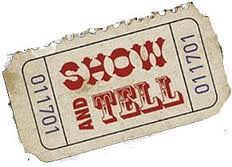(Actually, the title should be “show, don’t tell”)
I’ve been doing a lot of beta reading and critique swaps in the last few weeks and I’ve noticed a few reoccurring pitfalls. These easy-to-fix-yourself problems have inspired me to do a series posts covering: Show & Tell, Verbs, Redundancy, and as a bonus, I may even attempt to do a post on “Voice.”
Below are the top two occurrences I’ve found of authors using “tell” when they should “show”.
Felt- If you say “he felt” you’re automatically about to tell me something. In first person POV this is especially heinous because the reader knows the feeling must belong to the focal character. It would be a POV violation if it didn’t.
Tell: I felt myself settle down
Show: The tightness in my chest eased and my heart stopped pounding to be let out of my rib cage.
Looked- Anytime “looked” appears around an emotional description, replace it with a visual picture. (I’m a big fan of body language and facial descriptions.)
Tell: She looked depressed. (Oh boo-hoo.)
Show: The corners of her mouth dipped into a rueful frown. Her shoulders slumped.
Body language is non-verbal communication which consists of posture, gestures, eye movements, and facial expressions.
- Crossed arms over the chest
- Shrugged shoulders (Yes, I know that’s redundant)
- Yawning
- Leaning/angling toward or away from someone
- Lack of contact/extended eye contact/averted gaze
- Touching the ear/chin/cheek
- Tilting the head to one side
- Excessive blinking
- Hands on hips
- Straightened/slumped posture
- Puffed chest
- Playing with hair/hands in hair

A side note on facial expressions:
Smiled/Frowned/Grinned- I view these as weak facial expressions. I suggest replacing most of them with other facial expressions/body language, or at least justifying its use with a visual.
He flashed him a smile of glistening white piano keys.
A wide smile threatened to swallow his face.
Small lines of tension formed at the corner of his eyes and the muscle in his jaw twitched.
Dialogue
The 5 senses
Character actions
Figurative language
Showing doesn’t mean you need a paragraph to describe every event. A line or two here and there is sufficient.
Tell: He answered the phone and carried on a short conversation.
Show: He flipped open the phone. “What’s up?” He listened quietly, grunting in agreement every now and then or nodding. “Yeah, I can do that.”
Tell: We took off on our dirt bikes.
Show: Mud kicked off the back tire as he sped forward. Releasing the clutch and rolling throttle hard, I chased after him.
Feel free to offer other suggestions in the comments!




My roughs always contains tons of "he looked". And as soon as I see them I scream and chop away. Great post!
yeah, i'm with julie. My rough drafts always contain a lot of "he was sad" or tevs. BUT! That's why i love the find option in word. It's one of the first changes i make when i'm doing line edits. I just search for all the "he was" or "he felt" etc until i've fixed all the ones that need fixing
I'm guilty of committing the "looked" crime. :/
Luckily, I have awesome crit partners who find them and flog me for over usage. 🙂
Lots of useful info here. Great post!
Great post! This is one of those things that I have to work with. I'm such a teller! =D
Absolutely fantastic blog!!! Glad I found it! Love it!!!
Lola x
http://lola-x.blogspot.com
You have a fabulous blog! I’m an author and illustrator and I made some awards to give to fellow bloggers whose sites I enjoy. It’s not a pass on award. This is just for you to keep. I want to award you the Brilliant Writer Blog Award for all the hard work you do!
Go to http://astorybookworld.blogspot.com/p/awards.html and pick up your award.
~Deirdra
Awesome post! Loved the visuals too. 🙂
BTW I'm having difficulty following the blog. Will keep working on it!